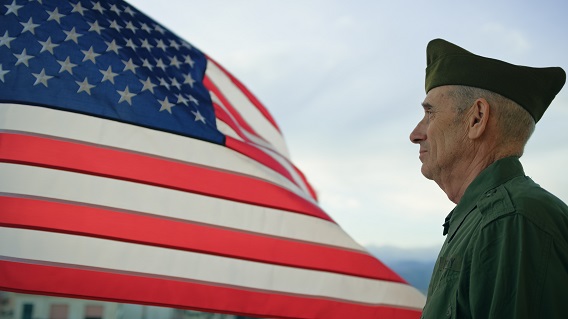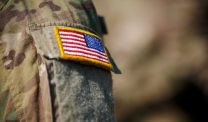Veterans Day: Personal Reflections at The Mesothelioma Center
Veterans & MilitaryWritten by Travis Rodgers | Edited By Amy Edel

Veterans Day is a way for our country to honor all veterans past and present. It’s meant to thank all of those who served in each branch of the military. The theme for Veterans Day 2024 is “A Legacy of Loyalty and Service.”
“Veterans Day is a day to remember the service of all veterans and active duty service members and reconnect with those we served with,” says Aaron Munz, former U.S. Army Captain and Director of Veterans Department for The Mesothelioma Center at Asbestos.com.
“I am proud to be part of the 5% of the current U.S. population that served. It was the defining experience of my young adulthood,” Aaron adds. “It taught me discipline, sacrifice, teamwork and leadership that has benefitted the rest of my life. I appreciate all of my fellow veterans who took the oath every day, but it’s special for the country to feel the same way on November 11th each year.”
Medical Officer Catherine Perrault recently joined The Mesothelioma Center’s team of Patient Advocates after a career in the U.S. Navy. She says her time serving her country was a life changing experience that forged many unbreakable bonds.
“This Veterans Day feels deeply personal for me, as it is my first as a veteran,” Catherine shares. “Reflecting on my years in the Navy fills me with nostalgia, pride and gratitude. My 13 years of service as a Navy physician transformed me and showed me that true dedication is all-encompassing—it’s a commitment that doesn’t end at the workday’s close but follows you everywhere. Serving in the Navy was not simply a job. It was a life that shaped every part of who I am today.”
Catherine adds, “As a physician, I was privileged to support military members and their families, knowing that my role was a key piece of a larger mission. I count myself lucky to have experienced the closeness, sacrifice and mutual support that come with military life. In those difficult moments—deployments, separations and challenges—friendships were forged that feel like family. We lifted each other up, often when we had barely anything left to give and I’ll always be grateful for those connections. This Veterans Day, I am proud to stand alongside my fellow veterans, honoring the resilience, sacrifice and dedication that define our shared journey.”
A Survivor and Veteran’s Perspective
Veterans Day can stir up complicated emotions for veterans with an asbestos-related illness. Of the 3,000 people diagnosed with mesothelioma in the U.S. each year, veterans make up 30% of that group. Unfortunately asbestos has disproportionately impacted veterans for decades.
The toxic mineral was widely used in every branch of the military for several decades. Many military service members were exposed to asbestos in the line of duty. This often happened in the course of their daily tasks, including maintenance work or working with asbestos-containing equipment. In combat or demolition, soldiers can also be exposed to asbestos in damaged buildings
U.S. Navy Veteran Jerry Cochran was told he had 5 years to live 50 years ago. Doctors diagnosed Cochran with asbestosis. This interstitial lung disease causes scarring and inflammation as a result of inhaling asbestos fibers.
Jerry tells us his first assignment in the Navy was on the USS Independence in Portsmouth, Virginia. He was 19 years old. The aircraft carrier used asbestos-containing products, including nonskid paint to prevent fighter jets from sliding off of the ship when landing.
He was tasked with scraping off the asbestos paint. Jerry was given no protective equipment and began having breathing problems soon after starting the job. He was medically discharged from the Navy 3 years later.
“We thought we were fighting for our country, but we weren’t given the equipment to properly protect ourselves,” Jerry tells us. “If we had been in combat, we would have been trained how to fight the enemy. But asbestos was an enemy we couldn’t and didn’t know how to fight.”
Jerry adds, “I went in to serve. I didn’t bargain for what I got. I knew there were dangers associated with being in the Navy. I knew that if the ship was attacked, I would die and go down with the ship. But I didn’t understand the fact that there were things in my environment that could easily take me out as if I was attacked by the enemy.”
Reflecting on Veterans Day he notes, “It’s good being recognized on Veterans Day. But it would be even better if we were recognized concerning situations that occurred while we were on active duty.”
Key Developments for Veterans This Year
This Veterans Day we’re highlighting some key developments from over the course of 2024 that affect all veterans. These impact veterans benefits, the U.S. Department of Veterans Affair’s database and the banning of some uses of asbestos.
Healthcare Expansion and Expanded Access to Benefits
In March 2024, the VA announced a new effort to expand healthcare nationwide for thousands of veterans through a new system. The VA’s Access Sprints is an initiative expanding access to healthcare.
It offers night and weekend clinics. The changes began in October 2023. Just in the time from when the changes began and February 2024, the VA saw around 25,000 more new patients compared to the same time a year ago. They say new patient appointments also increased 11%.
The U.S. Department of Veterans Affairs also took action in In August 2024 to expand access to benefits for Veterans who served at K2 and their survivors. K2, also known as Karshi-Khanabad Air Base, is a former Soviet air base in Uzbekistan. The U.S. Army, Air Force and the Marines used the base to support missions in Afghanistan between 2001 and 2005.
- Presumptive conditions: Chronic multi-symptom illness were made presumptive conditions for K2 Veterans. This will lower the burden of proof required for veterans who served at K2 to receive presumptive benefits for these conditions.
- Recognition of exposures: The VA also plans to take steps to acknowledge veterans who served at K2 were exposed to several contaminants of concern. This includes jet fuel, volatile organic compounds, particulate matter and dust, asbestos roofing tiles and lead-based paint.
- Fully accounting for toxins: The VA will ensure toxic exposures are fully taken into account when processing K2 veterans’ claims. This will mean that every time a K2 veteran submits a disability claim, VA claims processors and examiners will take those K2 exposures into account.
- Pre-decisional review: Before a decision is made on a K2 veteran’s claim, it’ll go through an additional review to ensure all relevant information (including exposures) was taken into account, and that all benefits to which the veteran is entitled have been granted.
The VA will continue to evaluate more ways to support K2 Veterans and their survivors. Also every veteran who served at K2 and meets basic eligibility requirements may enroll in VA healthcare without having to apply for disability compensation first. These veterans are also eligible for presumptive benefits for the more than 300 conditions the PACT Act covers.
“At VA, our goal is to provide every veteran who served at K2 with the care and benefits that they deserve for their service to our nation,” said the VA’s Under Secretary for Benefits Josh Jacobs. “And that’s what this effort is all about.”
National Asbestos Ban and Redesigned Registry
A nationwide chrysotile asbestos ban was finalized in March 2024. The ban follows decades of calls from survivors of asbestos-related diseases and veterans.
Chrysotile asbestos, also known as white asbestos, is still being imported into the country mainly for use in the chloralkali industry. American companies have 12 years to phase the material out of the manufacturing process. The new ban only applies to this specific type of asbestos.
In August 2024, the VA redesigned the Airborne Hazards and Open Burn Pit Registry. The registry is a database of health information of veterans and service members to help the VA understand and improve the way they treat veterans exposed to airborne hazards from burn pits.
The burn pit registry started in 2014. This new version of the registry utilizes veteran feedback, expands participation criteria, automatically includes participants in the registry and simplifies participation requirements.
The registry includes more than 4 million veterans. The VA considers the registry a catalyst for advancing new treatments for veterans. Burn pits can contain many dangerous materials including asbestos, heavy metals and toxic chemicals. Being around burn pits can cause a number of health issues.
“The Burn Pit Registry is fueling groundbreaking research and enabling VA’s ability to identify and proactively address health challenges that toxic-exposed veterans face at a population level,” Dr. Shereef Elnahal, undersecretary for health at the VA, explained.
History of Veterans Day
This national holiday evolved from Armistice Day, which commemorated the end of World War I. The end of the First World War occurred on the 11th hour of the 11th day of the 11th month of 1918. This was when the Armistice with Germany went into effect ending all fighting on the land, sea or air.
Congress expanded the day to include recognition of all veterans in 1954. U.S. President Dwight D. Eisenhower issued a “Veterans Day Proclamation,” renaming Armistice Day to Veterans Day.
Annually on Veterans Day, Americans observe a 2 minute moment of silence starting at 2:11 p.m. Eastern Time. People in different time zones observe the moment at other times. The Veterans Day Moment of Silence Act, which calls on the president to issue a proclamation each year requesting Americans observe a moment of silence, became law in 2016.






